AN EXAMINATION OF HIP
GRADING
The phenotypic evaluation
of hips done by the Orthopedic Foundation
for Animals falls into seven different
categories. Those categories are Normal (Excellent, Good, Fair), Borderline,
and Dysplastic (Mild, Moderate, Severe).
Once each of the radiologists classifies the
hip into one of the 7 phenotypes above, the
final hip grade is decided by a consensus of
the 3 independent outside evaluations.
Examples would be:
-
Two radiologists
reported Excellent, one Good—the
final grade would be Excellent
-
One radiologist
reported Excellent,
one Good, one Fair—the final
grade would be Good
-
One radiologist
reported Fair, two radiologists
reported Mild—the
final grade would be Mild
The hip grades of Excellent, Good and Fair
are within normal limits and are given OFA
numbers. This information is accepted by AKC
on dogs with permanent identification
(tattoo, microchip) and is in the public
domain. Radiographs of Borderline, Mild,
Moderate and Severely dysplastic hip grades
are reviewed by the OFA radiologist and a
radiographic report is generated documenting
the abnormal radiographic findings. Unless
the owner has chosen the open database,
dysplastic hip grades are not in the public
domain.
Excellent: this classification is assigned
for superior conformation in comparison to
other animals of the same age and breed.
There is a deep seated ball (femoral head)
which fits tightly into a well-formed socket
(acetabulum) with minimal joint space. There
is almost complete coverage of the socket
over the ball.
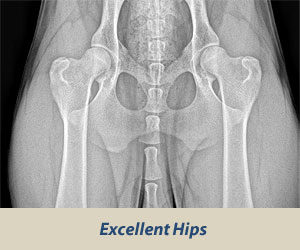
Good: slightly less than superior but a
well-formed congruent hip joint is
visualized. The ball fits well into the
socket and good coverage is present.
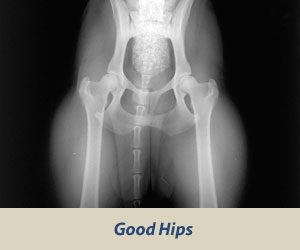
Fair: Assigned where minor irregularities in
the hip joint exist. The hip joint is wider
than a good hip phenotype. This is due to
the ball slightly slipping out of the socket
causing a minor degree of joint
incongruency. There may also be slight
inward deviation of the weight-bearing
surface of the socket (dorsal acetabular
rim) causing the socket to appear slightly
shallow. This can be a normal finding in
some breeds however, such as the Chinese
Shar Pei, Chow Chow, and Poodle.
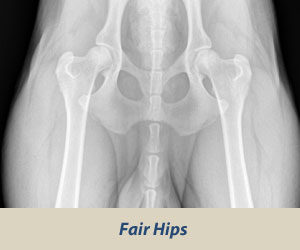
Borderline: there is no clear cut consensus
between the radiologists to place the hip
into a given category of normal or
dysplastic. There is usually more
incongruency present than what occurs in the
minor amount found in a fair but there are
no arthritic changes present that
definitively diagnose the hip joint being
dysplastic. There also may be a bony
projection present on any of the areas of
the hip anatomy illustrated above that can
not accurately be assessed as being an
abnormal arthritic change or as a normal
anatomic variant for that individual dog. To
increase the accuracy of a correct
diagnosis, it is recommended to repeat the
radiographs at a later date (usually 6
months). This allows the radiologist to
compare the initial film with the most
recent film over a given time period and
assess for progressive arthritic changes
that would be expected if the dog was truly
dysplastic. Most dogs with this grade (over
50%) show no change in hip conformation over
time and receive a normal hip rating;
usually a fair hip phenotype.
Mild Hip Dysplasia: there is significant
subluxation present where the ball is
partially out of the socket causing an
incongruent increased joint space. The
socket is usually shallow only partially
covering the ball. There are usually no
arthritic changes present with this
classification and if the dog is young (24
to 30 months of age), there is an option to
resubmit an radiograph when the dog is older
so it can be reevaluated a second time. Most
dogs will remain dysplastic showing
progression of the disease with early
arthritic changes. Since HD is a chronic,
progressive disease, the older the dog, the
more accurate the diagnosis of HD (or lack
of HD).
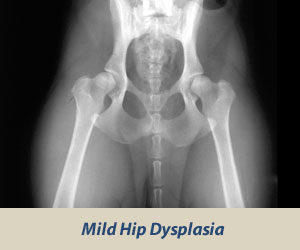
Moderate Hip Dysplasia: there is significant
subluxation present where the ball is barely
seated into a shallow socket causing joint
incongruency. There are secondary arthritic
bone changes usually along the femoral neck
and head (termed remodeling), acetabular rim
changes (termed osteophytes or bone spurs)
and various degrees of trabecular bone
pattern changes called sclerosis. Once
arthritis is reported, there is only
continued progression of arthritis over
time.
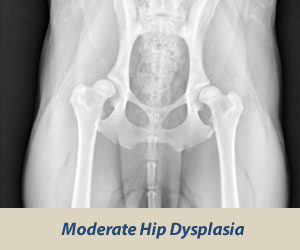
Severe Hip Dysplasia: assigned where
radiographic evidence of marked dysplasia
exists. There is significant subluxation
present where the ball is partly or
completely out of a shallow socket. Like
moderate HD, there are also large amounts of
secondary arthritic bone changes along the
femoral neck and head, acetabular rim
changes and large amounts of abnormal bone
pattern changes.
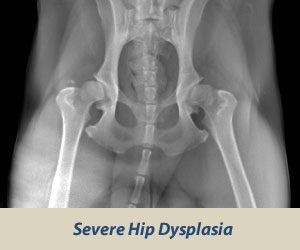
Other Hip Dysplasia Registries—An
Approximation
|
OFA |
FCI (European) |
BVA (UK/Australia) |
SV (Germany) |
|
Excellent |
A-1 |
0-4 (no > 3/hip) |
Normal |
|
Good |
A-2 |
5-10 (no > 6/hip) |
Normal |
|
Fair |
B-1 |
11-18 |
Normal |
|
Borderline |
B-2 |
19-25 |
Fast Normal |
|
Mild |
C |
26-35 |
Noch Zugelassen |
|
Moderate |
D |
36-50 |
Mittlere |
|
Severe |
E |
51-106 |
Schwere |
ELBOW DYSPLASIA GRADES
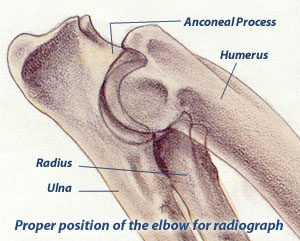 Elbow
dysplasia has multiple inherited etiologies
which may occur singularly or in
combination. These etiologies include fragmented
medial coronoid (FCP) of the ulna,
osteochondritis of the medial humeral
condyle and ununited
anconeal process (UAP). The most
sensitive view used to diagnose secondary
degenerative changes in the elbow joint is
an extreme flexed medio-lateral view of the
elbow which is required by the OFA and
recommended by the International Elbow
Working Group. The veterinary radiologists
are most interested in the appearance of the
anconeal process of the ulna. Elbow
dysplasia has multiple inherited etiologies
which may occur singularly or in
combination. These etiologies include fragmented
medial coronoid (FCP) of the ulna,
osteochondritis of the medial humeral
condyle and ununited
anconeal process (UAP). The most
sensitive view used to diagnose secondary
degenerative changes in the elbow joint is
an extreme flexed medio-lateral view of the
elbow which is required by the OFA and
recommended by the International Elbow
Working Group. The veterinary radiologists
are most interested in the appearance of the
anconeal process of the ulna.
When there is instability of the elbow joint
due to elbow dysplasia, one of the most
sensitive radiographic findings is new bone
proliferation (osteophytes) on the anconeal
process of the ulna associated with
secondary developmental degenerative joint
disease.
Bone proliferation can be very subtle to
visualize in some dogs and may require the
use of a special light source (hot light)
rather than a traditional view box to
diagnose it. Other arthritic findings such
as sclerosis in the area of the trochlear
notch of the ulna and bone spurs at joint
edges are also reported. If fragmentation of
the medial coronoid only involves the
cartilage, it may not be seen
radiographically but occasionally if the
bone is also fragmented, it can be
visualized as a separate calcific opacity
superimposed over the radius.
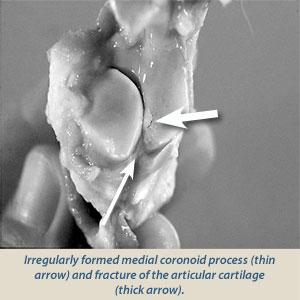 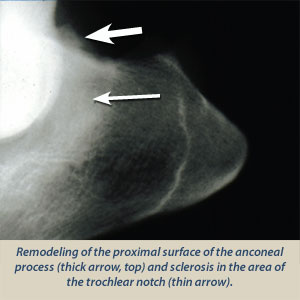
Grading Elbows
For elbow evaluations, there are no
grades for a radiographically normal elbow.
The only grades involved are for abnormal
elbows with radiographic changes associated
with secondary degenerative joint disease.
Like the hip certification, the OFA will not
certify a normal elbow until the dog is 2
years of age. The OFA also accepts
preliminary elbow radiographs. To date,
there are no long term studies for
preliminary elbow examinations like there
are for hips, however, preliminary screening
for elbows along with hips can also provide
valuable information to the breeder.
- Grade
I Elbow Dysplasia: Minimal
bone change along anconeal process of
ulna (less than 2mm).
- Grade
II Elbow Dysplasia: Additional bone
proliferation along anconeal process
(2-5 mm) and subchondral bone changes
(trochlear notch sclerosis).
- Grade
III Elbow Dysplasia: Well
developed degenerative joint disease
with bone proliferation along anconeal
process being greater than than 5 mm.
Gentester (DNA-tester)
SKKs
avelskommitté informerar om genetiska tester
Liten lathund för olika
gentest
HD = Höftledsdysplasi
som graderas från A till E, varav grad A är
det önskvärda, men även grad B är godkänd för
avel.
AD = Armbågsdysplasi
som gradera från 0 till 3. Här är det grad 0
som gäller. Grad 1 till 3 innebär att hunden
har sjukdomen AD.
ED = Elbow Dysplasia är engelska för
Armbågsdysplasi.
Både HD och AD är s k tillväxtsjukdomar, vilket innebär att valpen
inte har denna sjukdom när den föds. Däremot
kan den ha en genetisk belastning som gör
att den senare i livet kan utveckla en eller
i värsta fall båda dessa sjukdomar. HD och
AD omfattas följaktligen inte av s k Dolda
fel i uppfödarens försäkring av valpkullen.
Ett dolt fel ska ha funnits hos
valpen vid födseln men har ej kunnat
upptäckas vid veterinärbesiktningen av
valpen.
Prcd-PRA är en
ögonsjukdom som i slutändan ger blindhet.
Den är inte smärtsam för hunden som t ex HD
och AD. Numera kan man via ett gentest ta
reda på om anlaget finns hos presumtiva
avelsdjur - ett s k OptiGen test som
graderas enligt följande:
A = fri från anlaget, B = anlagsbärare och C
= sjuk. En individ med anlaget B får endast
paras med en fri individ = A.
EIC = Exercise-induced
collapse är en neurologisk sjukdom där
överföringen av impulser mellan nerver och
muskulatur inte fungerar som den ska. EIC
nedärvs med autosomal recessiv arvsgång, d v s
både tikar och hanar drabbas och hundarna
delas in i normala, anlagsbärare respektive
sjuka. Det krävs två defekta gener för att
utveckla sjukdomen.
CNM =
Centronukleär myopati
är en
muskelsjukdom, som också kallas
hereditary myopathy of the Labrador
Retriever eller Labrador Retriever Myopathy
finns i en liknande form hos människor.
De klassiska symptomen är att valpen vid
cirka 2-5 månaders ålder tappar i vikt och
att den får en stel gång, tål motion sämre,
och blir muskelsvag. Musklerna utvecklas
inte normalt. Hunden får också
tillväxtproblem.
HNPK =
Hereditary nasal
parakeratosis eller s k skrovelnos är en genetisk sjukdom där hundens nos blir
torr och skrovlig. Blodiga sprickbildningar
kan förekomma, vilket kan leda till kronisk
irritation och inflammation i hundens
nosparti. Sjukdomen är obotlig men
lindrigare fall kan behandlas.
Labradoren - en sund
hundras
Man ska ha klart för sig att
sjukdomar drabbar alla raser i mer eller
mindre hög grad precis som hos oss själva.
Labradoren är generellt sett en
förhållandevis frisk och sund ras och
dessutom väldigt lättskött när det gäller
pälsvård. I kombination med ett godmodigt
sinnelag och stabilt temperament är
Labradoren utan tvekan ett utmärkt förstaval
av familjehund.
Att gentesta är
frivilligt
Att gentesta sitt
avelsmaterial är upp till
varje uppfödare att avgöra. Labradorklubben
ställer inga krav på gentest. Däremot
måste avelsdjuren vara röntgade på höfter
(HD) och armbågar (AD) samt ögonlysta utan
anmärkning för valphänvisning.
Förvånande nog
kräver SKK
(Svenska Kennelklubben) endast känt
höftledsstatus samt ögonlysning för
registrering av valpkull. Känt höftledsstatus kan
vara alltifrån A till E. Ej heller krävs
armbågsröntgen, trots att armbågsdysplasi
(AD) anses vara ärftlig precis som höftledsdysplasi (HD).
Personligen
har jag valt att gentesta mina avelsdjur när
jag finner det motiverat. Man ska komma ihåg
att genetiken är komplicerad och att det
oftast är ett flertal gener som samverkar
vid sjukdomsanlag. Inget gentest är 100 %
säkert eftersom mutationer och icke kända
genkonstellationer kan uppstå. Vissa
gentester är säkrare än andra. Personligen
finner jag det bättre att testa för en
sjukdom/defekt om man finner det nödvändigt
än att inte testa alls.
Varför gentesta för
prcd-PRA och EIC?
Varför har jag
då valt att gentesta för prcd-PRA och EIC?
Jo, för att det förstnämnda omfattas av
ett bekämpningsprogram inom vår ras och
resultatet registreras officiellt hos SKK.
När det gäller EIC har framkommit att ca 30
% av de testade labradorerna bär anlaget i
enkel uppsättning och 3-5 % uppges vara
sjuka, d v s ha dubbla sjukdomsanlag, vilket
innebär att EIC är något mer utbrett jämfört
med prcd-PRA.
Caccia Sherlock Holmes
är även testad för CNM och HNPK och
fri/clear. Detta för
att en tikägare bad mig testa för det sistnämnda
och jag själv tyckte att det var lika bra
att ta det förstnämnda på samma gång
eftersom Sherlock initialt är hereditärt fri
från anlag för prcd-PRA och EIC via sina
föräldrar. Hans mor Taleem Give N Take At
Tapeatom "Ronja" är testad för prcd-PRA
och EIC och fri.
I Danmark är både Caccia
Stand By Me och DECH, VDHCH,
NORDJV-12 Caccia Only You hereditärt
fria från anlag för prcd-PRA och EIC, men
även testade för CNM och HNPK och fria. Deras
kullbror Caccia King Creole, också
han i Danmark, är testad för HNPK och fri.
Caccia Naevia "Mollie"
har ingen egen prcd-PRA eller EIC status
eftersom hennes far inte är testad. Dock är
hennes mor "Ronja" testad och fri.
På
Labradorklubbens hemsida finns utförlig
information om gentest och ärftliga
sjukdomar. Länken dit är
www.labradorklubben.se/avel.html
/Katja
|
|